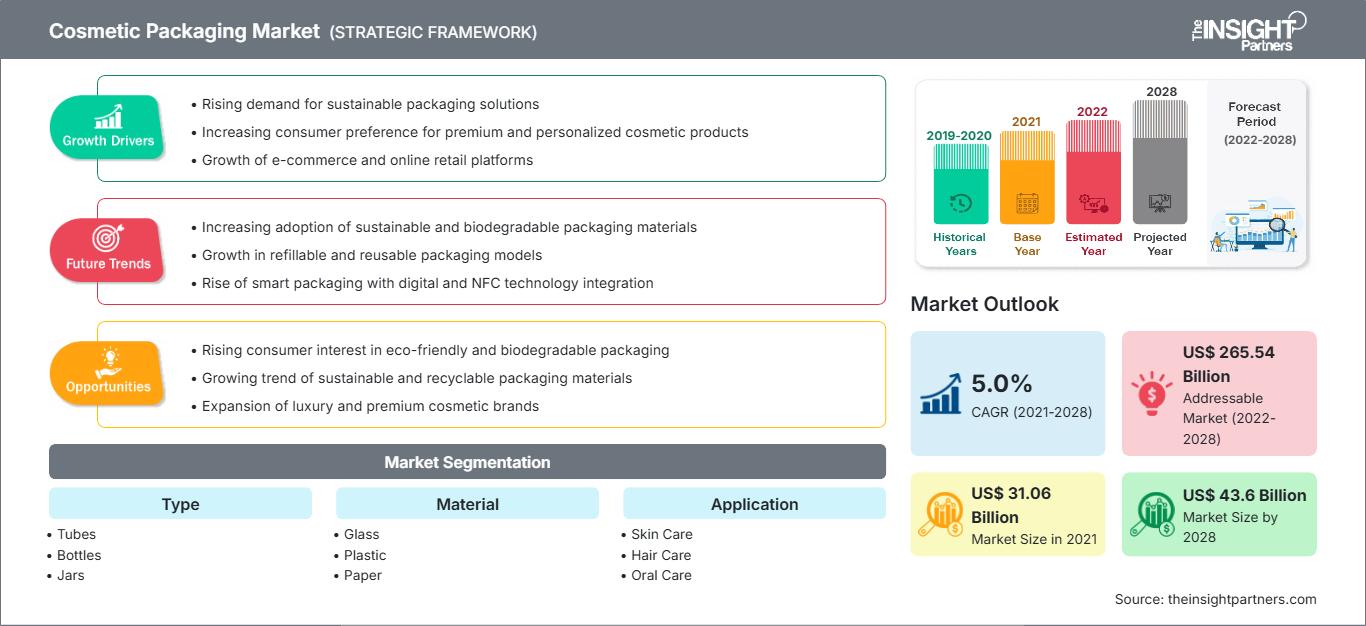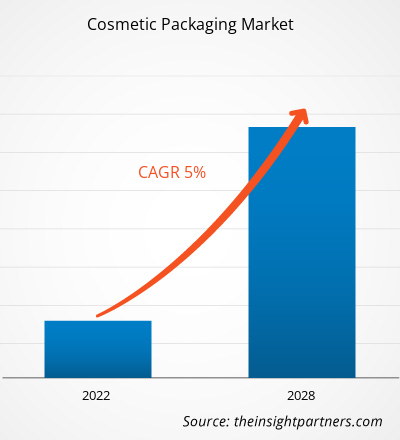Der Markt für Kosmetikverpackungen wurde im Jahr 2021 auf 31.064,7 Millionen US-Dollar geschätzt und soll bis 2028 43.597,9 Millionen US-Dollar erreichen; von 2021 bis 2028 wird ein CAGR-Wachstum von 5,0 % erwartet.
Das Marktwachstum ist auf die schnell wachsende Kosmetikindustrie, den zunehmenden Trend zum Schminken bei Frauen und die steigende Zahl von Make-up-Studios, Schönheitskliniken und Salons weltweit zurückzuführen. Darüber hinaus konzentrieren sich die Hersteller auf bessere Verpackungsdesigns und darauf, ihre Produkte durch innovative Verpackungen intelligent zu vermarkten, um Verbraucher anzulocken. Auch der steigende Absatz von Kosmetikprodukten über Online-Einzelhandelskanäle wird das Marktwachstum im Prognosezeitraum unterstützen. Im Jahr 2020 hatte der asiatisch-pazifische Raum den größten Anteil am globalen Markt für Kosmetikverpackungen und wird im Prognosezeitraum voraussichtlich die höchste CAGR des Marktes verzeichnen. Der Markt im asiatisch-pazifischen Raum ist in China, Indien, Japan, Südkorea und Australien unterteilt. Länder wie Südkorea, China und Japan zählen aufgrund der wachsenden Beliebtheit ihrer einzigartigen Make-up- und Hautpflegeroutinen zu den wichtigsten Märkten für Kosmetik- und Körperpflegeprodukte. Der Markt für Kosmetikverpackungen im asiatisch-pazifischen Raum verzeichnet aufgrund der rasanten Urbanisierung, der bemerkenswerten wirtschaftlichen Entwicklung, der kulturellen Vielfalt und der zunehmenden Akzeptanz neuer Make-up-Trends ein deutliches Wachstum.
Passen Sie diesen Bericht Ihren Anforderungen an
Sie erhalten kostenlos Anpassungen an jedem Bericht, einschließlich Teilen dieses Berichts oder einer Analyse auf Länderebene, eines Excel-Datenpakets sowie tolle Angebote und Rabatte für Start-ups und Universitäten.
Markt für Kosmetikverpackungen: Strategische Einblicke

- Holen Sie sich die wichtigsten Markttrends aus diesem Bericht.Dieses KOSTENLOSE Beispiel umfasst Datenanalysen, die von Markttrends bis hin zu Schätzungen und Prognosen reichen.
Auswirkungen der COVID-19-Pandemie auf den Markt für Kosmetikverpackungen
Die COVID-19-Pandemie beeinträchtigte die Betriebseffizienz des verarbeitenden Gewerbes erheblich. Grund dafür waren anhaltende Lockdowns in verschiedenen Regionen, Produktionsschließungen, Reise-, Handels- und Lieferkettenbeschränkungen sowie Rohstoffengpässe. Die COVID-19-Pandemie wirkte sich negativ auf den globalen Markt für Kosmetikverpackungen aus, da Produktionsstätten geschlossen, Rohstoffpreise gestiegen, Arbeitskräftemangel herrschte, Lieferketten unterbrochen und finanzielle Instabilität herrschte. Die Beeinträchtigung der Kosmetikindustrie durch den COVID-19-Ausbruch bremste zudem das Wachstum des Marktes für Kosmetikverpackungen. Allerdings erholen sich Unternehmen wieder, da zuvor verhängte Beschränkungen in verschiedenen Ländern gelockert werden. Die Einführung von COVID-19-Impfstoffen durch Regierungen verschiedener Länder hat die Situation weiter entspannt und zu einem Anstieg der Geschäftstätigkeit weltweit geführt. Regierungen verschiedener Länder planen zudem den Aufbau einer modernen und technologisch fortschrittlichen Infrastruktur, um die wirtschaftlichen Auswirkungen der Pandemie abzumildern. Während des Lockdowns haben Verbraucher Hautpflegebehandlungen und -therapien zu Hause durchgeführt, was die Nachfrage nach Kosmetikprodukten deutlich angekurbelt hat. Trotz der Auswirkungen der COVID-19-Pandemie wird daher erwartet, dass der Markt für Kosmetikverpackungen in den kommenden Jahren deutlich wachsen wird.Sie erhalten kostenlos Anpassungen an jedem Bericht, einschließlich Teilen dieses Berichts oder einer Analyse auf Länderebene, eines Excel-Datenpakets sowie tolle Angebote und Rabatte für Start-ups und Universitäten.
Markt für Kosmetikverpackungen: Strategische Einblicke

- Holen Sie sich die wichtigsten Markttrends aus diesem Bericht.Dieses KOSTENLOSE Beispiel umfasst Datenanalysen, die von Markttrends bis hin zu Schätzungen und Prognosen reichen.
Markteinblicke: Wächstende Kosmetikbranche
In den letzten Jahren ist das Bewusstsein für das persönliche Erscheinungsbild der Menschen gestiegen, was zu einer steigenden Nachfrage nach Kosmetikprodukten geführt hat. Nordamerika und Europa gelten als die größten Kosmetikmärkte weltweit. Laut den Daten von L’Oréal verzeichnete die globale Kosmetikbranche im Jahr 2019 eine Wachstumsrate von 5,5 %. Laut Cosmetics Europe wuchs der europäische Kosmetikmarkt von 89,30 US-Dollar im Jahr 2018 auf 90,66 US-Dollar im Jahr 2019. Darüber hinaus wird erwartet, dass eine steigende Nachfrage nach Kosmetika aufgrund der veränderten Pflegetrends bei Männern und Frauen die Kosmetikbranche ankurbeln wird. In den letzten Jahren hat sich die Branche von einer auf Frauen ausgerichteten Produktbasis zu einer Branche entwickelt, die alle Geschlechter bedient, was die Kundenbasis der Branche erweitert hat. Die wachsende Kundenbasis der Kosmetikindustrie hat zu einer hohen Nachfrage nach Kosmetikverpackungen geführt und das Marktwachstum weiter vorangetrieben.
Anwendungseinblicke
Basierend auf der Anwendung ist der globale Markt für Kosmetikverpackungen in Hautpflege, Haarpflege, Mundpflege und Sonstiges unterteilt. Im Jahr 2020 machte das Segment Hautpflege den größten Umsatzanteil aus. Immer mehr Beauty-Influencer veröffentlichen verschiedene Make-up- und Hautpflege-Tutorials, die sich großer Beliebtheit erfreuen. Darüber hinaus treibt der zunehmende Trend zur Verwendung von Produkten wie Sonnenschutzcreme, hautregenerierenden Nachtcremes und Duftstoffen die Nachfrage nach Hautpflegeprodukten an. Kosmetikverpackungen werden für verschiedene Hautpflegeprodukte wie Feuchtigkeitscremes, Handcremes, Reinigungs- und Peelingprodukte verwendet. Verpackungen für Hautpflegeprodukte sollen das Produkt vor Luft, Licht, Hitze, Kälte, Feuchtigkeit, Staub und Schmutz schützen und es vor Manipulation bewahren. Beispielsweise werden Polypropylenverpackungen aufgrund ihrer Flexibilität in einer Vielzahl von Hautpflegeprodukten verwendet, was sie zu einer hervorragenden Wahl für Quetschtuben macht. Darüber hinaus haben Hautpflegemarken begonnen, die Umweltvorteile von Hautpflegeverpackungen zu erkennen.ALBEA; APC PACKAGING; AptarGroup, Inc.; Berry Global Inc.; Gerresheimer AG; WWP Beauty; Silgan Plastics.; Huhtamaki; LIBO Cosmetics; und HCP Packaging gehören zu den Akteuren auf dem Markt für Kosmetikverpackungen. Diese Unternehmen bieten ein breites Produktportfolio für den Markt. Die Unternehmen sind in den Entwicklungsregionen präsent, was lukrative Möglichkeiten für das Wachstum des Kosmetikverpackungsmarktes bietet. Die Marktteilnehmer entwickeln qualitativ hochwertige und innovative Produkte, um die Anforderungen der Kunden zu erfüllen.
Berichts-Spotlights
- Fortschrittliche Branchentrends im Markt für Kosmetikverpackungen helfen den Akteuren bei der Entwicklung effektiver langfristiger Strategien
- Geschäftswachstumsstrategien in entwickelten und sich entwickelnden Märkten
- Quantitative Analyse des Marktes für Kosmetikverpackungen von 2019 bis 2028
- Schätzung der weltweiten Nachfrage nach Kosmetikverpackungen
- Porters Fünf-Kräfte-Analyse zur Veranschaulichung der Wirksamkeit von Käufern und Lieferanten in der Branche
- Jüngste Entwicklungen zum Verständnis des Wettbewerbsmarktszenarios
- Markttrends und -aussichten sowie Faktoren, die das Wachstum des Marktes für Kosmetikverpackungen vorantreiben und hemmen
- Unterstützung im Entscheidungsprozess durch Hervorhebung von Marktstrategien, die das kommerzielle Interesse untermauern und zum Marktwachstum führen
- Die Größe des Marktes für Kosmetikverpackungen an verschiedenen Knotenpunkten
- Detaillierte Übersicht und Segmentierung des Marktes sowie der Kosmetikverpackungsbranche Dynamik
- Größe des Kosmetikverpackungsmarktes in verschiedenen Regionen mit vielversprechenden Wachstumschancen
Markt für Kosmetikverpackungen
Die Analysten von The Insight Partners haben die regionalen Trends und Faktoren, die den Markt für Kosmetikverpackungen im Prognosezeitraum beeinflussen, ausführlich erläutert. In diesem Abschnitt werden auch die Marktsegmente und die geografische Lage in Nordamerika, Europa, dem asiatisch-pazifischen Raum, dem Nahen Osten und Afrika sowie Süd- und Mittelamerika erörtert.Umfang des Marktberichts über Kosmetikverpackungen
| Berichtsattribut | Einzelheiten |
|---|---|
| Marktgröße in 2021 | US$ 31.06 Billion |
| Marktgröße nach 2028 | US$ 43.6 Billion |
| Globale CAGR (2021 - 2028) | 5.0% |
| Historische Daten | 2019-2020 |
| Prognosezeitraum | 2022-2028 |
| Abgedeckte Segmente |
By Typ
|
| Abgedeckte Regionen und Länder | Nordamerika
|
| Marktführer und wichtige Unternehmensprofile |
|
Dichte der Akteure auf dem Markt für Kosmetikverpackungen: Verständnis ihrer Auswirkungen auf die Geschäftsdynamik
Der Markt für Kosmetikverpackungen wächst rasant. Die steigende Nachfrage der Endverbraucher ist auf Faktoren wie veränderte Verbraucherpräferenzen, technologische Fortschritte und ein stärkeres Bewusstsein für die Produktvorteile zurückzuführen. Mit der steigenden Nachfrage erweitern Unternehmen ihr Angebot, entwickeln Innovationen, um den Bedürfnissen der Verbraucher gerecht zu werden, und nutzen neue Trends, was das Marktwachstum weiter ankurbelt.

- Holen Sie sich die Markt für Kosmetikverpackungen Übersicht der wichtigsten Akteure
Die „Globale Marktanalyse für Kosmetikverpackungen bis 2028“ ist eine spezialisierte und gründliche Studie der Chemie- und Materialindustrie mit besonderem Augenmerk auf der globalen Trendanalyse des Marktes für Kosmetikverpackungen. Der Bericht soll einen Überblick über den Markt mit detaillierter Marktsegmentierung bieten. Der Markt für Kosmetikverpackungen ist nach Produkttyp, Material, Anwendung und Geografie segmentiert. Nach Typ ist der Markt für Kosmetikverpackungen in Tuben, Flaschen, Tiegel, Pumpen und Spender und Sonstiges unterteilt. Nach Material ist der Markt in Glas, Kunststoff, Papier, Metall und Sonstiges segmentiert. Nach Anwendung ist der Markt für Kosmetikverpackungen in Hautpflege, Haarpflege, Mundpflege und Sonstiges segmentiert. Nach Geografisch ist der Markt grob in Nordamerika, Europa, Asien-Pazifik (APAC), Naher Osten und Afrika (MEA) sowie Süd- und Mittelamerika.
Firmenprofile
- ALBEA
- APC PACKAGING
- AptarGroup, Inc.
- Berry Global Inc.
- Gerresheimer AG
- WWP Beauty
- Silgan Plastics.
- Huhtamaki
- LIBO Cosmetics
- HCP Packaging
- Historische Analyse (2 Jahre), Basisjahr, Prognose (7 Jahre) mit CAGR
- PEST- und SWOT-Analyse
- Marktgröße Wert/Volumen – Global, Regional, Land
- Branchen- und Wettbewerbslandschaft
- Excel-Datensatz
Aktuelle Berichte
Verwandte Berichte
Erfahrungsberichte
Grund zum Kauf
- Fundierte Entscheidungsfindung
- Marktdynamik verstehen
- Wettbewerbsanalyse
- Kundeneinblicke
- Marktprognosen
- Risikominimierung
- Strategische Planung
- Investitionsbegründung
- Identifizierung neuer Märkte
- Verbesserung von Marketingstrategien
- Steigerung der Betriebseffizienz
- Anpassung an regulatorische Trends






















 Kostenlose Probe anfordern für - Markt für Kosmetikverpackungen
Kostenlose Probe anfordern für - Markt für Kosmetikverpackungen